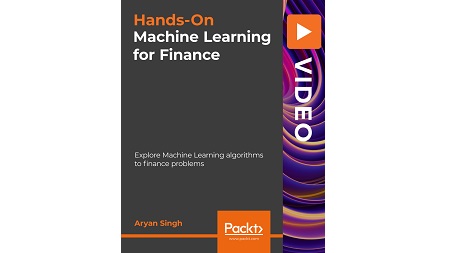
English | MP4 | AVC 1920×1080 | AAC 48KHz 2ch | 4h 30m | 5.07 GB
Machine Learning techniques for solving major financial issues
Machine Learning for Finance is a perfect course for financial professionals entering the fintech domain. It shows how to solve some of the most common and pressing issues facing institutions in the financial industry, from retail banks to hedge funds.
This video course focuses on Machine Learning and covers a range of analysis tools, such as NumPy, Matplotlib, and Pandas. It is packed full of hands-on code simulating many of the problems and providing working solutions.
This course aims to build your confidence and the experience to go ahead and tackle real-life problems in financial analysis. The industry is adopting automatic, data-driven algorithms at a rapid pace, and Machine Learning for Finance gives you the skills you need to be at the forefront.
By the end of this course, you will be equipped with all the tools from the world of Finance, machine learning and deep learning essential for tackling all these pressing issues in the area of Fintech.
Learn
- How to tackle problems in Fintech and financial investments
- Learn feature engineering, EDA and understanding with regards to financial data
- Build an ANN-based model for predicting the stock prices
- Enhance your Machine Learning skills with ensemble models like random forest and XGBoost.
- Enhance your understanding of Neural Networks to build regression-based models.
- Learn how to identify fraudulent transactions by building a fraud detection model by using classification models.
- Achieve efficient frontier by using features like Sharpe ratios and risk management.
Table of Contents
Financial Data Understanding, EDA, and Feature Engineering
1 The Course Overview
2 Visualization, EDA, and Feature Engineering of Financial Data
3 Features of the Stock Data
4 Univariate and Bivariate Analysis of Data
5 Deriving Moving Average and RSI Based Features
6 Data cleaning and Outlier Detection
7 Creating the Features and Independent Variable
8 Prepare Data for Modeling
Predicting the FOREX Currencies by Building a Linear Model
9 Linear Regression Intuition
10 Understanding of FOREX Markets Data
11 Pre-Process FOREX Currency Data for Model Input
12 Building the Linear Regression Model
13 R-Squared and Adjusted R-Squared as a Performance Metric
14 The Testing Significance of Features by Using p-value and VIF
15 Hyperparameter Tuning and Final Model Selection
Tree-Based Machine Learning Techniques for Stock Prediction
16 Decision Trees Intuition
17 Entropy and Information Gain Criterion for Tree Construction
18 Building a Decision Tree-Based Model for Predicting Stock Prices
19 Train Using Different Max Depth
20 Random Forest Intuition
21 Build a Random Forest Regressor for Predicting Stock Prices
22 Boosting and XGBoost Based Regression Model for Stock Prediction
Artificial Neural Networks Basics and Intuition
23 What a Neural Network Is
24 Feed Forward in Neural Networks
25 Gradient Descent in Neural Networks
26 Back Propagation in Neural Networks
27 Loss Function in Neural Networks
28 Hyperparameters in Neural Networks
Stock Price Prediction by Using Artificial Neural Networks
29 Prepare Data for Ingestion into the Neural Network
30 Define the Neural Network Layers and Model
31 Visualize Keras Model by using Pydot
32 Train the Model Using Basic Parameters
33 Analyze the Model Performance Using Loss and Accuracy Curves
34 Hyperparameter Tuning of Neural Network
35 Generating Predictions by Using the Trained Model
Modern Portfolio Theory and Techniques for Portfolio Management
36 MPT and Stock Data Intuition
37 Random Portfolio Generation and Portfolio Volatility
38 Sharpe Ratio for Optimum Portfolio
39 Portfolio Allocation Using Sharpe Ratio and Efficient Frontier
40 Maximum Sharpe Ratio with SciPy Optimization
41 Plotting and Visualizing Efficient Frontier
42 Final Portfolio Allocation and Visualization
Predicting Fraud in Financial Transactions by Using ANN classification
43 Softmax and Sigmoid Activation in Neural Networks
44 Categorical Cross Entropy Loss for Classification
45 Feature Engineering and Preprocess Data for Input into the Model
46 Creating the Model and the Optimizer
47 Training the Model
48 Handling Class Imbalance
49 Evaluating the Final Model and Predict Fraud Using the Model
Resolve the captcha to access the links!